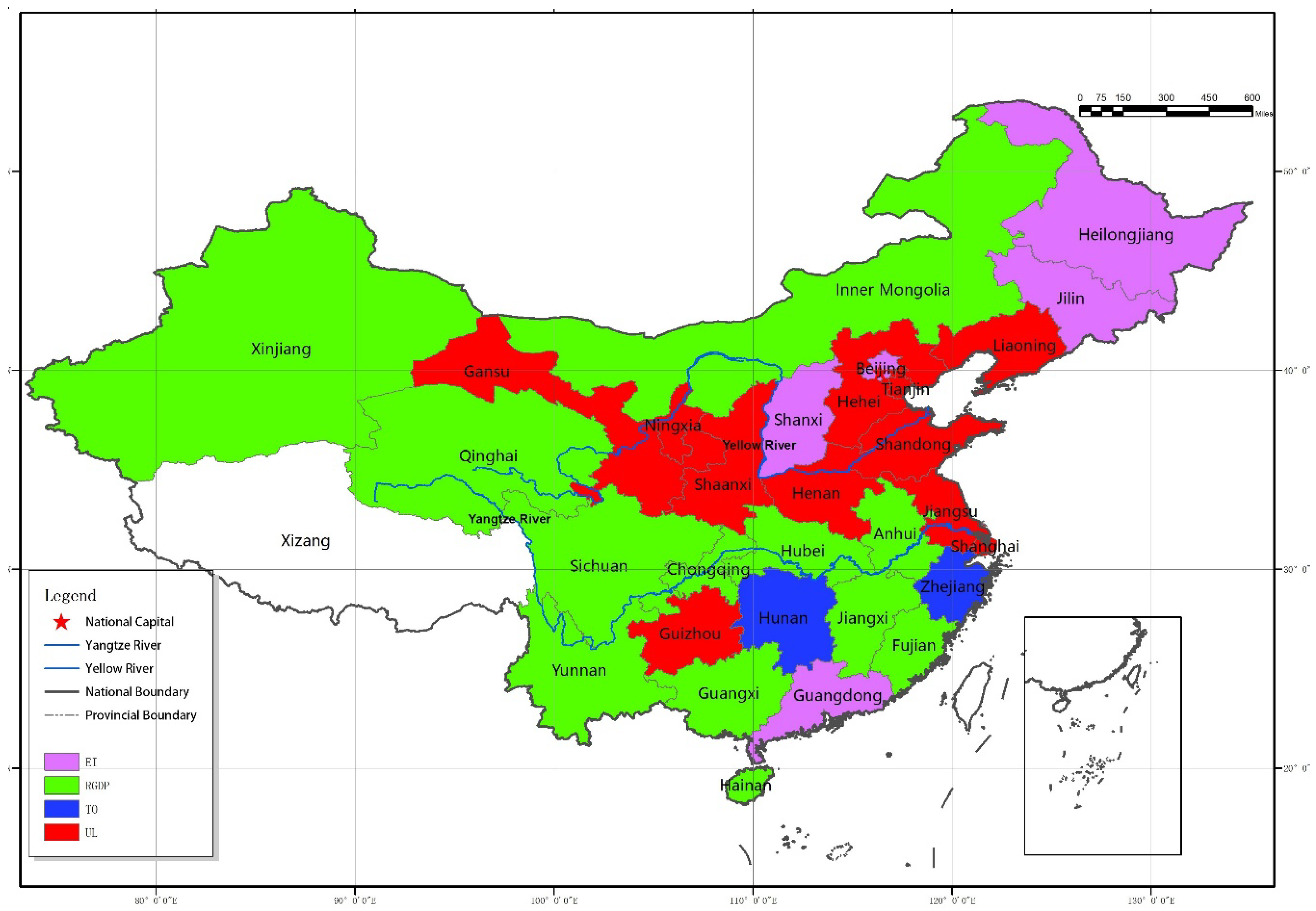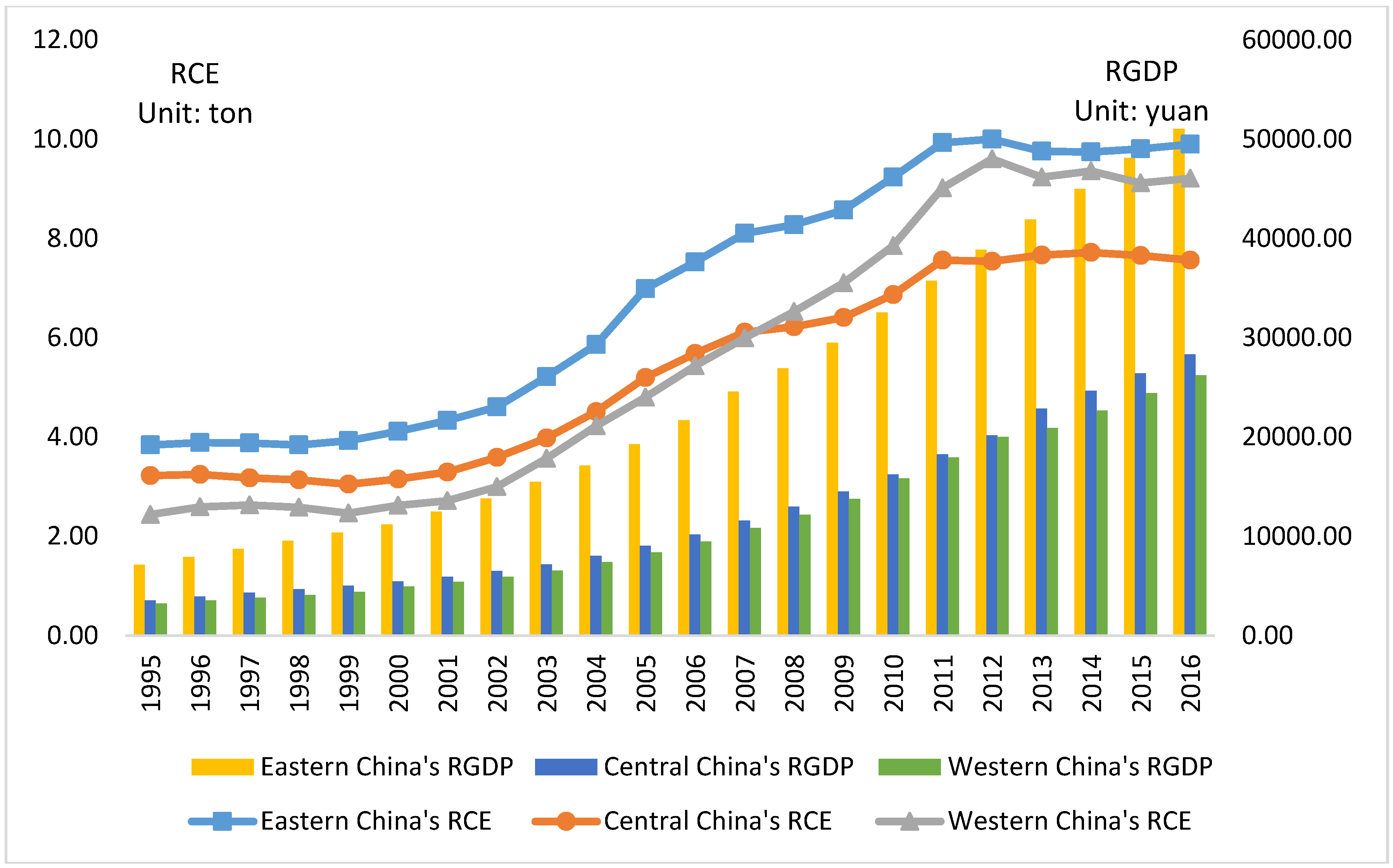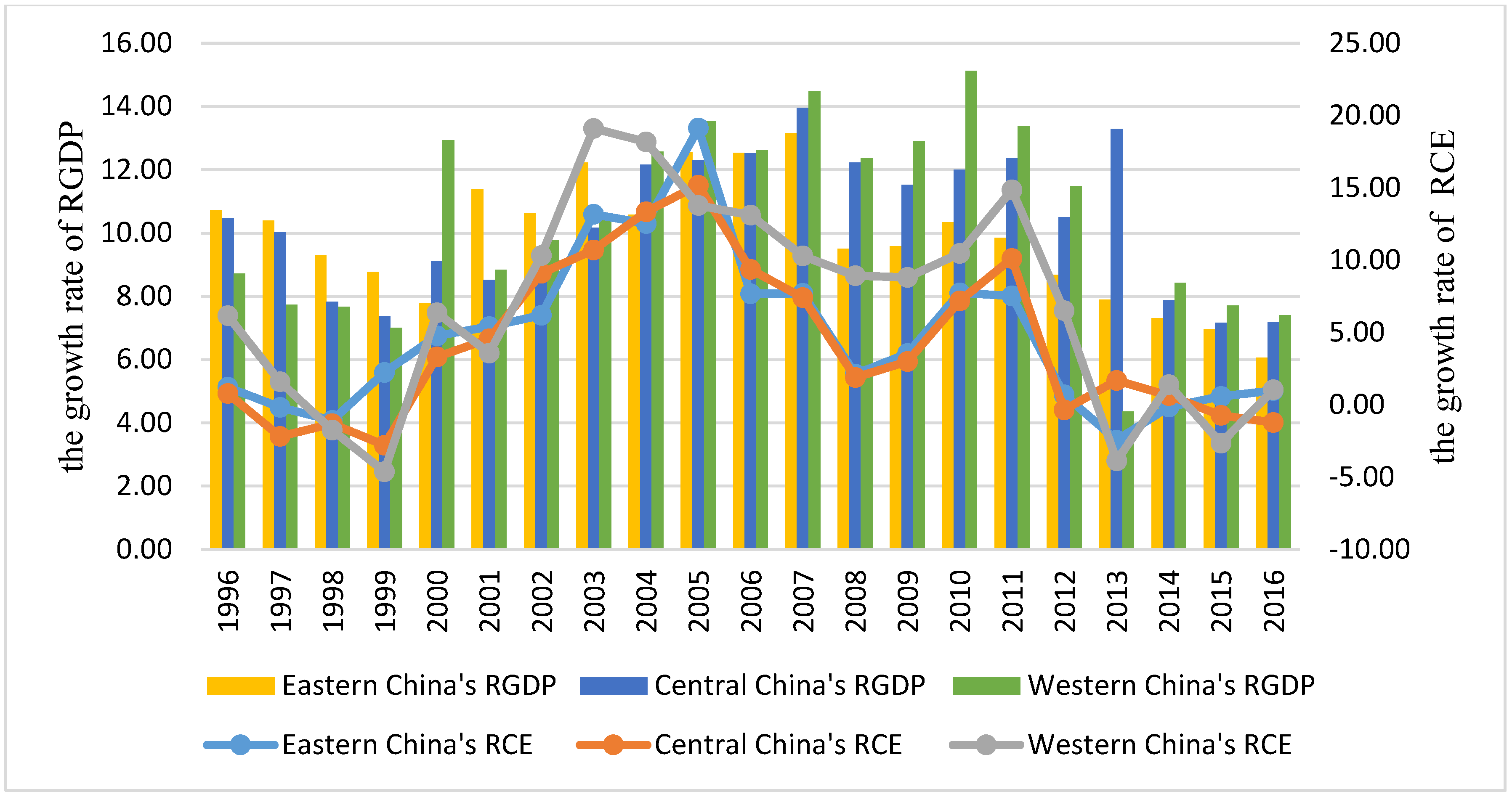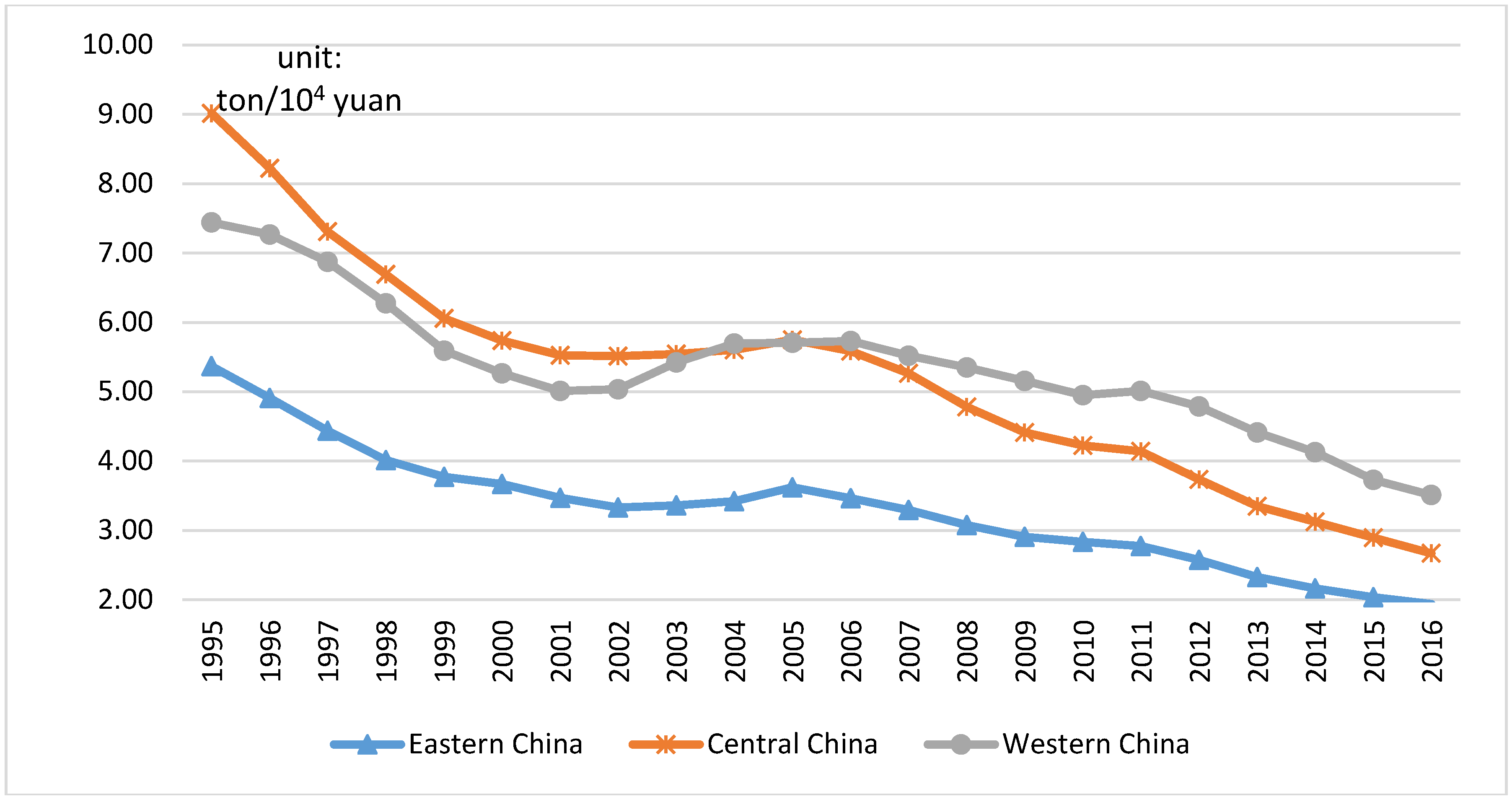Analysis of the Influence Mechanism of CO2 Emissions and Verification of the Environmental Kuznets Curve in China
Abstract
:1. Introduction
2. Literature Review
2.1. Analysis of Influencing Factors of CO2 Emissions
2.2. Relation between Economic Growth and CO2 Emissions
3. Modeling and Empirical Analysis of Panel Gray Relation
3.1. Modeling of Panel Gray Incidence Analysis
3.2. Empirical Analysis of Panel Gray Relation
3.2.1. Data Sources
3.2.2. Empirical Results of Panel Gray Incidence Analysis
4. Verification of EKC for CO2 Emissions in China
4.1. Model Establishment
4.2. Assumption Analysis of Verification Results
4.3. Empirical Result of EKC Model
5. Suggestions
6. Conclusions
Author Contributions
Funding
Acknowledgments
Conflicts of Interest
References
- The State Council of the People’s Republic of China. The Work Plan for Controlling Greenhouse Gas Emissions for the Thirteenth Five-Year Plan period. Available online: http://zwdt.ndrc.gov.cn/fwdt/fwdttzgg/201611/t20161107_825814.html (accessed on 7 November 2016).
- Xu, S.; He, Z.; Long, R. Factors that Influence Carbon Emissions Due to Energy Consumption in China: Decomposition Analysis Using LMDI. Appl. Energy 2014, 127, 182–193. [Google Scholar] [CrossRef]
- Fernández González, P.; Landajo, M.; Presno, M.J. Tracking European Union CO2 Emissions through LMDI (Logarithmic-Mean Divisia Index) Decomposition. The Activity Revaluation Approach. Energy 2014, 73, 741–750. [Google Scholar] [CrossRef]
- Wang, P.; Wu, W.; Zhu, B.; Wei, Y. Examining the Impact Factors of Energy-Related CO2 Emissions Using the STIRPAT Model in Guangdong Province, China. Appl. Energy 2013, 106, 65–71. [Google Scholar] [CrossRef]
- Zhang, C.; Lin, Y. Panel Estimation for Urbanization, Energy Consumption and CO2 Emissions: A Regional Analysis in China. Energy Policy 2012, 49, 488–498. [Google Scholar] [CrossRef]
- Wang, S.; Liu, X.; Zhou, C.; Hu, J.; Ou, J. Examining the Impacts of Socioeconomic Factors, Urban Form, and Transportation Networks on CO2 Emissions in China’s Megacities. Appl. Energy 2017, 185, 189–200. [Google Scholar] [CrossRef]
- Li, H.; Mu, H.; Zhang, M.; Gui, S. Analysis of Regional Difference on Impact Factors of China’s Energy—Related CO2 Emissions. Energy 2012, 39, 319–326. [Google Scholar] [CrossRef]
- Alam, M.M.; Murad, M.W.; Noman, A.H.M.; Ozturk, I. Relationships among Carbon Emissions, Economic Growth, Energy Consumption and Population Growth: Testing Environmental Kuznets Curve Hypothesis for Brazil, China, India and Indonesia. Ecol. Indic. 2016, 70, 466–479. [Google Scholar] [CrossRef]
- Rafindadi, A.A. Does the Need for Economic Growth Influence Energy Consumption and CO2 Emissions in Nigeria? Evidence from the Innovation Accounting Test. Renew. Sustain. Energy Rev. 2016, 62, 1209–1225. [Google Scholar] [CrossRef]
- Zhu, H.; Duan, L.; Guo, Y.; Yu, K. The Effects of FDI, Economic Growth and Energy Consumption on Carbon Emissions in Asean-5: Evidence from Panel Quantile Regression. Econ. Model. 2016, 58, 237–248. [Google Scholar] [CrossRef]
- Pao, H.; Tsai, C. Multivariate Granger Causality between CO2 Emissions, Energy Consumption, FDI (Foreign Direct Investment) and GDP (Gross Domestic Product): Evidence from a Panel of BRIC (Brazil, Russian Federation, India, and China) Countries. Energy 2011, 36, 685–693. [Google Scholar] [CrossRef]
- Abid, M. Impact of Economic, Financial, and Institutional Factors on CO2 Emissions: Evidence from Sub-Saharan Africa Economies. Util. Policy 2016, 41, 85–94. [Google Scholar] [CrossRef]
- Liang, S.; Zhang, T. What is Driving CO2 Emissions in a Typical Manufacturing Center of South China? The Case of Jiangsu Province. Energy Policy 2011, 39, 7078–7083. [Google Scholar] [CrossRef]
- Dong, F.; Wang, Y.; Zhang, X. Can Environmental Quality Improvement and Emission Reduction Targets be Realized Simultaneously? Evidence from China and a Geographically and Temporally Weighted Regression Model. Int. J. Environ. Res. Pub. Health 2018, 15, 2343. [Google Scholar] [CrossRef] [PubMed]
- Wang, K.; Wu, M.; Sun, Y.; Shi, X.; Sun, A.; Zhang, P. Resource Abundance, Industrial Structure, and Regional Carbon Emissions Efficiency in China. Resour. Policy 2019, 60, 203–214. [Google Scholar] [CrossRef]
- Li, Z.; Shao, S.; Shi, X.; Sun, Y.; Zhang, X. Structural Transformation of Manufacturing, Natural Resource Dependence, and Carbon Emissions Reduction: Evidence of a Threshold Effect from China. J. Clean. Prod. 2019, 206, 920–927. [Google Scholar] [CrossRef]
- Li, J.; Zhang, D.; Su, B. The Impact of Social Awareness and Lifestyles on Household Carbon Emissions in China. Ecol. Econ. 2019, 160, 145–155. [Google Scholar] [CrossRef]
- Ji, Q.; Xia, T.; Liu, F.; Xu, J. The Information Spillover between Carbon Price and Power Sector Returns: Evidence from the Major European Electricity Companies. J. Clean. Prod. 2019, 208, 1178–1187. [Google Scholar] [CrossRef]
- Ji, Q.; Zhang, D.; Geng, J. Information Linkage, Dynamic Spillovers in Prices and Volatility between the Carbon and Energy Markets. J. Clean. Prod. 2018, 198, 972–978. [Google Scholar] [CrossRef]
- Grossman, G.M.; Krueger, A.B. Economic Growth and the Environment. Q. J. Econ. 1995, 110, 353–377. [Google Scholar] [CrossRef]
- Shafik, N. Economic Development and Environmental Quality: An Econometric Analysis. Oxf. Econ. Pap. 1994, 46, 757–773. [Google Scholar] [CrossRef]
- Selden, T.M.; Song, D. Environmental Quality and Development: Is there a Kuznets Curve for Air Pollution Emissions? J. Environ. Econ. Manag. 1994, 27, 147–162. [Google Scholar] [CrossRef]
- Apergis, N. Environmental Kuznets Curves: New Evidence on Both Panel and Country-Level CO2 Emissions. Energy Econ. 2016, 54, 263–271. [Google Scholar] [CrossRef]
- Bilgili, F.; Koçak, E.; Bulut, Ü. The Dynamic Impact of Renewable Energy Consumption on CO2 Emissions: A Revisited Environmental Kuznets Curve Approach. Renew. Sustain. Energy Rev. 2016, 54, 838–845. [Google Scholar] [CrossRef]
- Bölük, G.; Mert, M. The Renewable Energy, Growth and Environmental Kuznets Curve in Turkey: An ARDL Approach. Renew. Sustain. Energy Rev. 2015, 52, 587–595. [Google Scholar] [CrossRef]
- Rafindadi, A.A. Revisiting the Concept of Environmental Kuznets Curve in Period of Energy Disaster and Deteriorating Income: Empirical Evidence from Japan. Energy Policy 2016, 94, 274–284. [Google Scholar] [CrossRef]
- Ben Jebli, M.; Ben Youssef, S. The Environmental Kuznets Curve, Economic Growth, Renewable and Non-Renewable Energy, and Trade in Tunisia. Renew. Sustain. Energy Rev. 2015, 47, 173–185. [Google Scholar] [CrossRef]
- Lin, B.; Omoju, O.E.; Nwakeze, N.M.; Okonkwo, J.U.; Megbowon, E.T. Is the Environmental Kuznets Curve Hypothesis a Sound Basis for Environmental Policy in Africa? J. Clean. Prod. 2016, 133, 712–724. [Google Scholar] [CrossRef]
- Saboori, B.; Sulaiman, J. Environmental Degradation, Economic Growth and Energy Consumption: Evidence of the Environmental Kuznets Curve in Malaysia. Energy Policy 2013, 60, 892–905. [Google Scholar] [CrossRef]
- Martínez-Zarzoso, I.; Bengochea-Morancho, A. Pooled Mean Group Estimation of an Environmental Kuznets Curve for CO2. Econ. Lett. 2004, 82, 121–126. [Google Scholar] [CrossRef]
- Kang, Y.; Zhao, T.; Yang, Y. Environmental Kuznets Curve for CO2 Emissions in China: A Spatial Panel Data Approach. Ecol. Indic. 2016, 63, 231–239. [Google Scholar] [CrossRef]
- Onafowora, O.A.; Owoye, O. Bounds Testing Approach to Analysis of the Environment Kuznets Curve Hypothesis. Energ. Econ. 2014, 44, 47–62. [Google Scholar] [CrossRef]
- Meng, Z.; Wang, H.; Wang, B. Empirical Analysis of Carbon Emission Accounting and Influencing Factors of Energy Consumption in China. Int. J. Environ. Res. Pub. Health 2018, 15, 2467. [Google Scholar] [CrossRef] [PubMed]
- Mao, M.; Chirwa, E.C. Application of Grey Model GM(1, 1) to Vehicle Fatality Risk Estimation. Technol. Forecast. Soc. Chang. 2006, 73, 588–605. [Google Scholar] [CrossRef]
- Xiao, X.; Wen, J.; Xie, M. Grey Relational Analysis and Forecast of Demand for Scrap Steel. J. Grey Syst. 2010, 22, 73–80. [Google Scholar]
- Liu, S.; Cai, H.; Yang, Y.; Cao, Y. Advance in Grey Incidence Analysis Modelling. Syst. Eng. Theory Pract. 2013, 33, 2041–2046. (In Chinese) [Google Scholar]
- Wang, Z.; Li, Q.; Pei, L. Grey Forecasting Method of Quarterly Hydropower Production in China Based on a Data Grouping Approach. Appl. Math. Model. 2017, 51, 302–316. [Google Scholar] [CrossRef]
- Wang, L.; Yin, K.; Cao, Y.; Li, X. A New Grey Relational Analysis Model Based on the Characteristic of Inscribed Core (IC-JRA) and Its Application on Seven-Pilot Carbon Trading Markets of China. Int. J. Environ. Res. Pub. Health 2019, 16, 99. [Google Scholar] [CrossRef] [PubMed]
- Qian, W.; Wang, Y.; Dang, Y.; Liu, S. Grey Matrix Relational and Its Application Based on Multivariate Panel Data. Syst. Eng. 2013, 10, 69–74. (In Chinese) [Google Scholar]
- Institute for Urban and Environmental Studies, Chinese Academy of social Sciences. Available online: http://iue.cass.cn/ktdt/gjbwkt/201507/t20150725_2413793.shtml (accessed on 30 March 2015).
- Hsiao, C. Analysis of Panel Data, 2nd ed.; Cambridge University Press: Cambridge, UK, 2014; pp. 142–187. [Google Scholar]
- Liu, Y.; Shi, X.; Laurenceson, J. Are China’s Exports Crowding Out or Being Crowded Out? Evidence from Japan’s Imports. China World Econ. 2018, 26, 1–23. [Google Scholar] [CrossRef]




| Regions | First | Second | Third | Fourth |
|---|---|---|---|---|
| Beijing | EI | UL | RGDP | TO |
| 0.9142 | 0.7981 | 0.7843 | 0.6736 | |
| Tianjin | UL | TO | EI | RGDP |
| 0.9151 | 0.8776 | 0.8586 | 0.8290 | |
| Hebei | UL | EI | RGDP | TO |
| 0.8364 | 0.8207 | 0.7977 | 0.7298 | |
| Liaoning | UL | EI | RGDP | TO |
| 0.8624 | 0.8484 | 0.8022 | 0.7562 | |
| Shanghai | UL | TO | EI | RGDP |
| 0.9492 | 0.8512 | 0.8268 | 0.8191 | |
| Jiangsu | UL | RGDP | TO | EI |
| 0.8924 | 0.8790 | 0.8242 | 0.7983 | |
| Zhejiang | TO | RGDP | UL | EI |
| 0.8994 | 0.8857 | 0.8781 | 0.8316 | |
| Fujian | RGDP | UL | TO | EI |
| 0.8066 | 0.7732 | 0.7410 | 0.7170 | |
| Shandong | UL | RGDP | TO | EI |
| 0.8759 | 0.8692 | 0.8074 | 0.7737 | |
| Guangdong | EI | RGDP | UL | TO |
| 0.8307 | 0.8294 | 0.7457 | 0.6213 | |
| Hainan | RGDP | UL | TO | EI |
| 0.8169 | 0.7330 | 0.6823 | 0.6519 | |
| Shanxi | EI | UL | RGDP | TO |
| 0.8140 | 0.7889 | 0.7655 | 0.7413 | |
| Jilin | EI | UL | RGDP | TO |
| 0.8724 | 0.8671 | 0.8455 | 0.8043 | |
| Heilongjiang | EI | RGDP | UL | TO |
| 0.8823 | 0.8694 | 0.8683 | 0.8509 | |
| Anhui | RGDP | UL | EI | TO |
| 0.8729 | 0.8434 | 0.7702 | 0.7211 | |
| Jiangxi | RGDP | UL | EI | TO |
| 0.8162 | 0.7330 | 0.7203 | 0.6768 | |
| Henan | UL | RGDP | TO | EI |
| 0.8958 | 0.8754 | 0.8579 | 0.7854 | |
| Hubei | RGDP | EI | TO | UL |
| 0.8531 | 0.8318 | 0.8128 | 0.8123 | |
| Hunan | TO | RGDP | UL | EI |
| 0.7914 | 0.7764 | 0.7434 | 0.7309 | |
| Inner Mongolia | RGDP | UL | EI | TO |
| 0.8752 | 0.7982 | 0.7739 | 0.7518 | |
| Guangxi | RGDP | EI | UL | TO |
| 0.6593 | 0.6508 | 0.6401 | 0.5832 | |
| Chongqing | RGDP | EI | UL | TO |
| 0.7110 | 0.6771 | 0.6529 | 0.6073 | |
| Sichuan | RGDP | UL | EI | TO |
| 0.6876 | 0.6677 | 0.6560 | 0.6503 | |
| Guizhou | UL | RGDP | TO | EI |
| 0.8727 | 0.8398 | 0.7921 | 0.7607 | |
| Yunnan | RGDP | UL | EI | TO |
| 0.7985 | 0.7518 | 0.6810 | 0.6728 | |
| Shaanxi | UL | RGDP | EI | TO |
| 0.8287 | 0.7924 | 0.7780 | 0.6305 | |
| Gansu | UL | RGDP | EI | TO |
| 0.8990 | 0.8768 | 0.8683 | 0.6695 | |
| Qinghai | RGDP | EI | UL | TO |
| 0.8364 | 0.7775 | 0.7649 | 0.5597 | |
| Ningxia | UL | EI | RGDP | TO |
| 0.8253 | 0.7891 | 0.7884 | 0.7177 | |
| Xinjiang | RGDP | UL | EI | TO |
| 0.8989 | 0.8694 | 0.8538 | 0.6977 |
| Line-Type | |||
|---|---|---|---|
| N | |||
| Inverted-U | |||
| U | |||
| Inverted-U | |||
| Upward sloping straight line | |||
| Downward sloping straight line | |||
| None |
| Variables | Eastern China | Central China | Western China |
|---|---|---|---|
| LnRGDP3 | −0.156 *** | −0.140 *** | −0.107 *** |
| (−5.69) | (−5.01) | (−3.81) | |
| LnRGDP2 | 4.495 *** | 3.923 *** | 2.895 *** |
| (5.50) | (5.08) | (3.78) | |
| LnRGDP1 | −42.39 *** | −36.08 *** | −25.26 *** |
| (−5.22) | (−5.07) | (−3.64) | |
| LnEI | 0.653 *** | 0.271 *** | 0.540 *** |
| (10.45) | (5.32) | (3.21) | |
| LnUL | 1.051 *** | 0.546 *** | −0.226 * |
| (9.72) | (6.08) | (−1.92) | |
| LnTO | −0.202 *** | 0.101 *** | −0.144 *** |
| (−4.97) | (3.47) | (−4.42) | |
| 127.7 *** | 107.9 *** | 70.93 *** | |
| (4.78) | (4.94) | (3.36) | |
| R2 | 0.8973 | 0.9491 | 0.877 |
| Number of province | 11 | 8 | 11 |
| Observations | 242 | 176 | 242 |
| F | 63.14 | 603.47 | 122.56 |
| Item | Solution | Eastern China | Central China | Western China |
|---|---|---|---|---|
| Inflection point | LnRGDP1 | 8.31 | 8.18 | 7.3922 |
| LnRGDP2 | 10.90 | 10.50 | 10.6451 | |
| Inflection point (original value) | RGDP1 | 4064.31 | 3568.85 | 1623.27 |
| RGDP2 | 54,176.36 | 36,315.50 | 41,986.36 | |
| Line-type | Inverted-N | Inverted-N | Inverted-N | |
© 2019 by the authors. Licensee MDPI, Basel, Switzerland. This article is an open access article distributed under the terms and conditions of the Creative Commons Attribution (CC BY) license (http://creativecommons.org/licenses/by/4.0/).
Share and Cite
Fang, D.; Hao, P.; Wang, Z.; Hao, J. Analysis of the Influence Mechanism of CO2 Emissions and Verification of the Environmental Kuznets Curve in China. Int. J. Environ. Res. Public Health 2019, 16, 944. https://doi.org/10.3390/ijerph16060944
Fang D, Hao P, Wang Z, Hao J. Analysis of the Influence Mechanism of CO2 Emissions and Verification of the Environmental Kuznets Curve in China. International Journal of Environmental Research and Public Health. 2019; 16(6):944. https://doi.org/10.3390/ijerph16060944
Chicago/Turabian StyleFang, Debin, Peng Hao, Zhengxin Wang, and Jian Hao. 2019. "Analysis of the Influence Mechanism of CO2 Emissions and Verification of the Environmental Kuznets Curve in China" International Journal of Environmental Research and Public Health 16, no. 6: 944. https://doi.org/10.3390/ijerph16060944
APA StyleFang, D., Hao, P., Wang, Z., & Hao, J. (2019). Analysis of the Influence Mechanism of CO2 Emissions and Verification of the Environmental Kuznets Curve in China. International Journal of Environmental Research and Public Health, 16(6), 944. https://doi.org/10.3390/ijerph16060944






